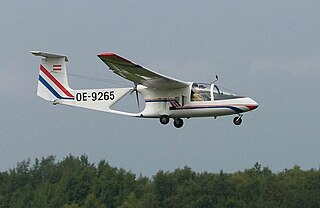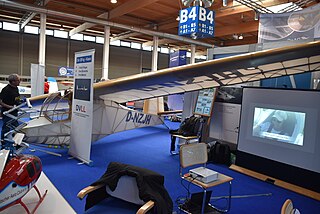
The Schleicher ASW 15 is a one-seat sailplane designed in 1968 by Gerhard Waibel and manufactured by Alexander Schleicher GmbH & Co. The ASW 15 has shoulder-mounted wings and an all-flying tailplane, with its single tow-release placement a compromise between winching and aerotowing. The later ASW 15B had several improvements, including a tow-release placed on the plane of symmetry, an 11 cm taller rudder, a slightly larger main wheel, and the provision of a 90-litre water ballast system.

The Glaser-Dirks DG-400 is a single-seat self-launching motorglider that was produced by Glaser-Dirks between 1981 and 1992. It was the first self-launching motorglider with retractable engine and propeller to be produced in large numbers.

The Brditschka HB-3, HB-21 and HB-23 are a family of motor gliders of unorthodox configuration developed in Austria in the early 1970s.

The VSO 10 Vosa is a Standard and Club-Class glider designed and manufactured in the Czechoslovak Republic from December 1978 as a replacement for the VT-116 Orlik II.

The LAK-12 is a Lithuanian mid-wing, single-seat, FAI Open Class glider that was designed and produced by Lietuviškos Aviacinės Konstrukcijos (LAK) in Lithuania and later by Sportine Aviacija and Sport Aviation USSR.
The ProFe D-10 Tukan is a Czech high-wing, strut-braced, T-tailed, two-seat motor glider that was designed and produced by ProFe and made available in kit form for amateur construction.
The ProFe Banjo is a family of Czech high-wing, strut-braced, T-tailed gliders and motor gliders designed and produced by ProFe in kit form for amateur construction.
The TeST TST-1 Alpin is a Czech shoulder-wing, single-seat, pusher configuration motor glider that was designed and produced by TeST.
The TeST TST-6 Duo is a Czech shoulder-wing, two-seats in side-by-side configuration motor glider that was designed and produced by TeST of Brno.
The TeST TST-7 Junior is a Czech shoulder-wing, single-seat motor glider that was designed and produced by TeST of Brno. When it was available the aircraft was supplied as plans, in kit form for amateur construction or as a complete ready-to-fly aircraft. Production is now complete and the aircraft is no longer available new.
The Aviastroitel AC-7M is a Russian mid-wing, T-tailed, two-seats in side-by-side configuration motor glider that was designed by Vladimir Egorovich Fedorov and produced by Aviastroitel, now Glider Air Craft.

The EEL ULF 1 is a West German high-wing, single-seat, foot-launched, microlift glider that was designed by Dieter Reich. When it was available it was provided in the form of plans by Entwicklung und Erprobung von Leichtflugzeugen (EEL) for amateur construction. By the end of 2019 the company website had been take down and it is likely that the company has gone out of business.
The Barel Graal is a French mid-wing, T-tailed single-seat motor glider that was designed by Max Barel and produced by Graal Aéro as a complete ready-to-fly aircraft or as a kit for amateur construction.

The Protoplane Ultra is a French ultralight aircraft, designed and produced by Protoplane of Bagnères-de-Bigorre. The aircraft is supplied as a complete ready-to-fly aircraft.
The Civil Aviation Department MG-1 was a one-off Indian motor glider, seating two side by side and first flown in 1983.
The Aérostructure Lutin 80, earlier known as the PLM 80, is a small, single seat motor glider with a low power pusher configuration engine, designed and built in France in the 1980s. Only two were completed.
The Pipistrel Apis-Bee, also called the Apis/Bee, is a Slovenian mid-wing, single-seat glider and motor glider, that was designed and produced by Pipistrel.

The Distar UFM-13 Lambada is a Czech shoulder-wing, two-seat motor glider originally designed and produced by Urban Air and now built by Distar Air of Ústí nad Orlicí.
The Nippi NP-100 Albatross was a Japanese two side-by-side seat motorized glider, powered by a ducted fan rather than the usual propeller. It did not go into production.
The Wega 180 is a Brazilian amateur-built aircraft designed and produced by Wega Aircraft of Palhoça, Santa Catarina, introduced at the Sun 'n Fun airshow in 2013. The aircraft is supplied as a kit for amateur construction or as a complete ready-to-fly-aircraft.








